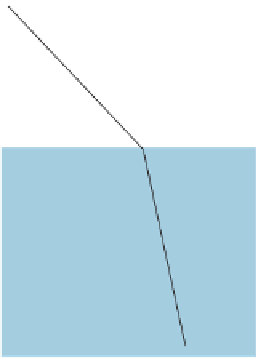Graphics Reference
In-Depth Information
y
Inline Exercise 26.5:
What happens when
Δ
y
=
0 and
Δ
z
=
π
?
Δ
z
is not a multiple
of
2
, or where
A
y
and
A
z
differ. In this case, the projection of the field vectors to
the
yz
-plane forms an
ellipse,
and the light is said to be
elliptically polarized.
It
turns out that an elliptically polarized field can always be expressed as the sum
of a circularly polarized one and a linearly polarized one, with the axis of linear
polarization being along the major axis of the ellipse (see Exercise 26.11).
Finally (see Figure 26.10), there are cases where
Δ
y
−
z
x
There are materials called
polarizers
that are transparent to waves of one
polarization but opaque to those of the opposite polarization.
Light traveling in some direction
d
and reflected from a shiny surface with
normal vector
n
, when reflected, ends up preferentially linearly polarized with the
polarization direction being
d
Figure 26.10: Elliptical polariza-
tion
n
. Such reflected light, when observed through a
polarizer that favors light of some other polarization, will be attenuated. This is
the principle by which polarized sunglasses filter reflected sunlight. The precise
nature of reflected polarized light depends on the reflecting material, as we'll see
in Section 26.5.
×
In a related phenomenon, light passing from one medium to another changes
speed. The speed of light in a vacuum is the highest possible speed; in other mate-
rials it may be substantially slower, due to the virtual transitions mentioned earlier.
As a result, when light passes from a vacuum to some material it slows down. This
does not affect the frequency of the light, that is, the number of peaks of electro-
magnetic radiation arriving at a fixed point in a fixed amount of time. You can
convince yourself of this by observing a person who jumps into a swimming pool:
The color of his or her clothing does not appear to change whether you're seeing
it through water and air or just air. The speed change does affect the wave
length,
however, which is determined by
λ
=
s
/
f
,
where
s
is the speed of light in whatever medium it's traveling through and
f
is the
frequency.
The
index of refraction
or
refractive index
of a medium is the ratio of the
speed of light in a vacuum to the speed of light in that medium. It's denoted by
the letter
n
. Typical indices of refraction are 1 for a vacuum, 1.0003 for air, 1.33
for water, and 2.42 for diamond.
The difference of refractive index in different media causes a macroscopic
phenomenon: Light rays bend when they go from one medium to another. The
conventional name for the precise description of the bending is
Snell's law,
although the phenomenon of a consistent law of refraction was known to Ibn Sahl
of Baghdad as early as 984 CE [Ras90].
1
2
θ
1
and
θ
2
denote the angles between the ray and the surface normal on the two sides of
the interface, and
n
1
and
n
2
denote the two indices of refraction, then
n
2
The bending follows a particularly simple form (see Figure 26.11): If
Figure 26.11: Bending of a light
ray passing from one medium to
another.
n
1
=
sin
θ
1
θ
2
.
sin



























































































































